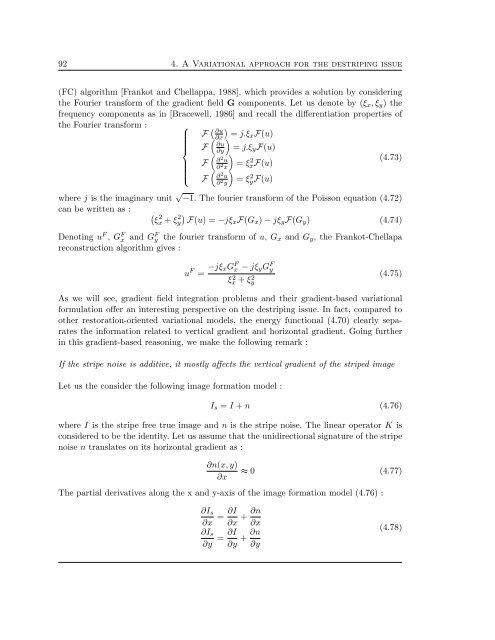Th`ese Marouan BOUALI - Sites personnels de TELECOM ParisTech
Th`ese Marouan BOUALI - Sites personnels de TELECOM ParisTech
Th`ese Marouan BOUALI - Sites personnels de TELECOM ParisTech
You also want an ePaper? Increase the reach of your titles
YUMPU automatically turns print PDFs into web optimized ePapers that Google loves.
92 4. A Variational approach for the <strong>de</strong>striping issue<br />
(FC) algorithm [Frankot and Chellappa, 1988], which provi<strong>de</strong>s a solution by consi<strong>de</strong>ring<br />
the Fourier transform of the gradient field G components. Let us <strong>de</strong>note by (ξ x ,ξ y ) the<br />
frequency components as in [Bracewell, 1986] and recall the differentiation properties of<br />
the Fourier transform :<br />
F<br />
⎧⎪ ( ∂u<br />
( ∂x)<br />
) = j.ξx F(u)<br />
⎨ F ∂u<br />
∂y<br />
= j.ξ y F(u)<br />
( )<br />
F ∂ 2 u<br />
= ξ 2 (4.73)<br />
xF(u)<br />
⎪ ⎩<br />
∂ 2 x<br />
F<br />
(<br />
∂ 2 u<br />
∂ 2 y<br />
)<br />
= ξyF(u)<br />
2<br />
where j is the imaginary unit √ −1. The fourier transform of the Poisson equation (4.72)<br />
can be written as :<br />
(<br />
ξ<br />
2<br />
x + ξy<br />
2 )<br />
F(u) =−jξx F(G x ) − jξ y F(G y ) (4.74)<br />
Denoting u F , G F x and G F y the fourier transform of u, G x and G y , the Frankot-Chellapa<br />
reconstruction algorithm gives :<br />
u F = −jξ xG F x − jξ y G F y<br />
ξ 2 x + ξ 2 y<br />
(4.75)<br />
As we will see, gradient field integration problems and their gradient-based variational<br />
formulation offer an interesting perspective on the <strong>de</strong>striping issue. In fact, compared to<br />
other restoration-oriented variational mo<strong>de</strong>ls, the energy functional (4.70) clearly separates<br />
the information related to vertical gradient and horizontal gradient. Going further<br />
in this gradient-based reasoning, we make the following remark :<br />
If the stripe noise is additive, it mostly affects the vertical gradient of the striped image<br />
Let us the consi<strong>de</strong>r the following image formation mo<strong>de</strong>l :<br />
I s = I + n (4.76)<br />
where I is the stripe free true image and n is the stripe noise. The linear operator K is<br />
consi<strong>de</strong>red to be the i<strong>de</strong>ntity. Let us assume that the unidirectional signature of the stripe<br />
noise n translates on its horizontal gradient as :<br />
∂n(x, y)<br />
∂x<br />
≈ 0 (4.77)<br />
The partial <strong>de</strong>rivatives along the x and y-axis of the image formation mo<strong>de</strong>l (4.76) :<br />
∂I s<br />
∂x = ∂I<br />
∂x + ∂n<br />
∂x<br />
∂I s<br />
∂y = ∂I<br />
∂y + ∂n<br />
∂y<br />
(4.78)















